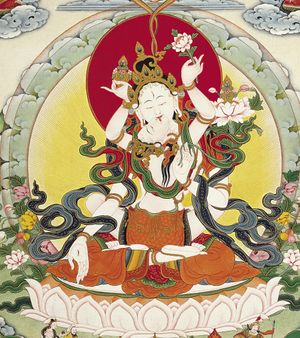Daily Practice of Chimé Pakmé Nyingtik: Difference between revisions
Jump to navigation
Jump to search
No edit summary |
No edit summary |
||
| (One intermediate revision by one other user not shown) | |||
| Line 4: | Line 4: | ||
==Notes== | ==Notes== | ||
<small><references/></small> | <small><references/></small> | ||
==External Links== | |||
*[http://all-otr.org/cpn/26-cpn-daily-single-mudra An Explanation of the ‘Single Mudra’: A Daily Practice from the Chimé Phakmé Nyingtik] by [[Orgyen Tobgyal Rinpoche]], [[Lerab Ling]] and Courbevoie, 26&28 July 2006 | |||
*[http://all-otr.org/cpn/9-chime-phakme-nyingtik-in-a-nutshell Chimé Phakmé Nyingtik in a Nutshell] by Orgyen Tobgyal Rinpoche, Bir, India, 21-22 September 2011 | |||
[[Category: Prayers and Practices]] | [[Category: Prayers and Practices]] | ||
[[Category:Tara]] | [[Category: Tara]] | ||
Latest revision as of 11:59, 26 August 2019

The Daily Practice of Chime Pakmé Nyingtik, or literally as the Tibetan title says: ‘The Daily Yoga Practice of Chimé Pakmé Nyingtik as a Single Deity[1]– The Heart Essence of the Sublime Lady of Immortality’ (Wyl. ‘chi med 'phags ma'i snying tig las/ rgyun gyi rnal 'byor phyag rgya gcig pa), is a sadhana practice from Jamyang Khyentse Wangpo’s mind treasure: Chimé Pakmé Nyingtik, a long life practice discovered in 1855, featuring White Tara in union with Amitayus. It is a briefer version of the root sadhana called ‘The Wisdom Light of Enlightened Activity’ (Wyl. phrin las ye shes snang ba)
Notes
External Links
- An Explanation of the ‘Single Mudra’: A Daily Practice from the Chimé Phakmé Nyingtik by Orgyen Tobgyal Rinpoche, Lerab Ling and Courbevoie, 26&28 July 2006
- Chimé Phakmé Nyingtik in a Nutshell by Orgyen Tobgyal Rinpoche, Bir, India, 21-22 September 2011